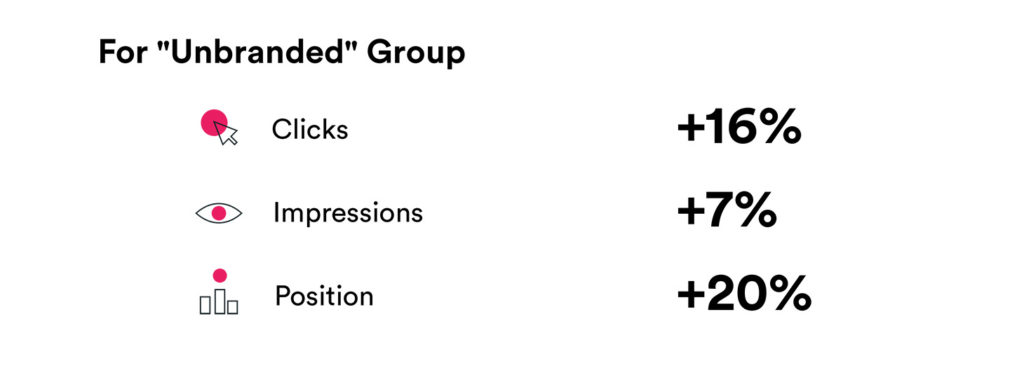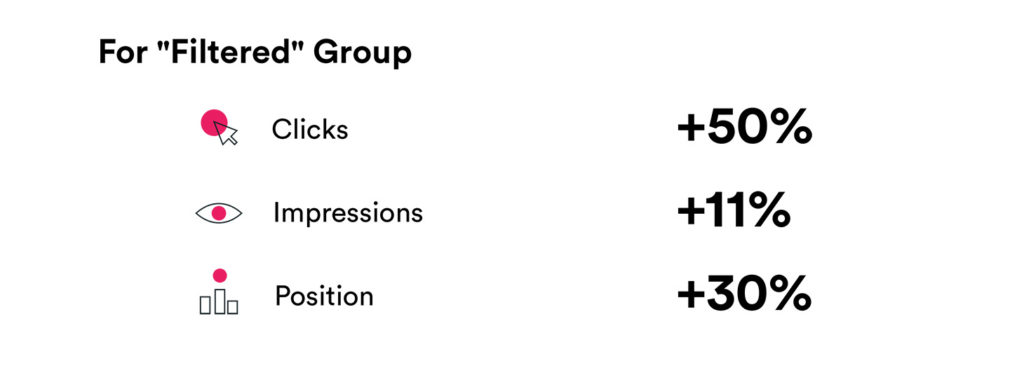The challenge
We conducted this test on an ecommerce platform that uses faceted navigation, meaning a user can technically create any URL using any number of facets available.
This essentially means that it’s impossible for an SEO to be able to manage titles and H1s for every indexable URL (even if you’re managing the index status for these faceted URLs). So, the obvious conclusion is the SEO manager has to determine an automated approach to creating title tags, allowing 95% of URLs to generate content automatically, and meaning they can focus on optimising the other 5% of high value product landing pages.
The approach taken on this ecommerce platform was to combine facets in the most logical order to essentially describe the indexed page, and because this was automated, to avoid any combinations not reading well, the titles included a special character between each facet.
For example, if the URL was created using the following facets:
- Grey
- Television
- Samsung
Then the title created would be “Grey – Samsung – Television” (in this case, the SEO also put in rules that determined how the facets should be ordered).
The question we had was – what impact are those special characters having on the performance of the page?
I’ll now outline how we went about answering it.
What are we testing?
In this test, we took a test group and measured the impact of removing the special character from the title. That would mean in the above example, the title was adapted from:
“Grey – Samsung – Television | Company Name”
To
“Grey Samsung Television | Company Name”
How are we testing this?
Test group
We tested the above implementation on 84 product landing pages and measured the impact of the implementation on all Google Search Console metrics.
To get more insightful data, we also split the dataset into 3 query sets:
- “All data” – meaning all queries, without any exclusions
- “Unbranded” – meaning all generic queries, with all branded queries and seasonal sale queries removed
- “Filtered” – meaning all generic queries, with all branded, seasonal sale and product line queries removed
Control group
To find the control group we market matched using all remaining URLs that were untouched during this period (to our knowledge). This essentially meant building a bank of untouched URLs from any associated domains.
Once we had this bank, we could determine which control set is most aligned with the test group – the closer alignment we can get, the more confidence we can have on the results.
What are the results?
Overall, there was a significant uplift across all metrics, showing us that by cleaning up titles we can improve organic performance. I’ve summarised the 2 most impactful query sets:
“Unbranded” Group
Within this group, we found a significant improvement in all 3 metrics measured. This includes a 20% uplift in position with a 90% significance. This translated into a 7% uplift for impressions and a 16% uplift in clicks.

“Filtered” Group
The most significant results were found with the “Filtered” group (which also happen to be the most unbranded queries), where we saw an impressive 30%+ improvement in position, with a >93% confidence that this was due to the updates made.
In actual numbers, that’s an average position move from around 4.6 to 3.1.
Similarly, in the same “filtered” group, we found a >50% uplift in clicks after making the implementation and a 11% uplift in impressions.

What does this tell us?
This tells us 2 key things:
- Creating titles without the inclusion of special characters, in this instance, has a positive impact on our ranking position. This means Google favours more readable titles that don’t include the use of special characters between each word.
- Titles without special characters also lead to an improvement in CTR outside of the natural uplift due to position. With such disparity between clicks and impressions, it shows users were more inclined to click on the result when special characters weren’t breaking up the title in any way.
This is just one example of when using SEOcausal, our very own causal impact model, has been hugely beneficial in how we can help the client showcase the impact of implementations and get buy in from the stakeholders.
